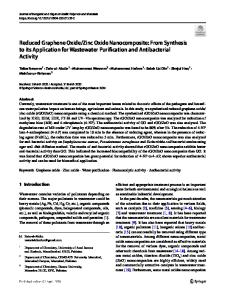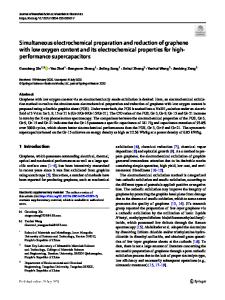Preparation of reduced graphene oxide/montmorillonite composite hydrogel and its applications for chromium(VI) and organ
- PDF / 1,769,922 Bytes
- 15 Pages / 439.37 x 666.142 pts Page_size
- 30 Downloads / 384 Views
Preparation of reduced graphene oxide/montmorillonite composite hydrogel and its applications for chromium(VI) and organic compounds adsorption Chundong Peng1 · Zetian He1 · Jiejie Feng1 · Daimei Chen1 · Hao Ding1 · Jiao Wang2 · Gaoxiang Du1 Received: 18 August 2020 / Accepted: 31 August 2020 © Springer Nature B.V. 2020
Abstract A novel 3D porous reduced graphene oxide/montmorillonite composite hydrogel (rGO–MMT) was prepared by solvent method, where the MMT nanosheets were homogenously dispersed in 3D rGO hydrogel. The porous 3D structure and the high dispersion of MMT nanosheets can promote the adsorption capacity. The effects of MMT content (wt%), the initial concentration of Cr(VI) solution (C0), pH value (pH0), the adsorption dose and temperatures on the adsorption capacity of rGO–MMT for Cr(VI) ions have been investigated. The optimum pH value for Cr(VI) adsorption is 2, and the adsorption capacity increases with MMT content and adsorption temperature. The rGO–MMT composite hydrogel displays the excellent adsorption property for both the heavy metal and organic pollutants. The adsorption capacity of rGO–MMT composite hydrogel is obviously higher than those of single rGO hydrogel and MMT due to the synergistic adsorption of rGO hydrogel and MMT. The adsorption of Cr(VI) ions on the rGO–MMT composite hydrogel follows linear pseudo-second-order kinetics, and the Langmuir model describes the adsorption process much better. Thermodynamic parameters indicate that adsorption is spontaneous, favorable and endothermic in nature.
Electronic supplementary material The online version of this article (https://doi.org/10.1007/s1116 4-020-04266-w) contains supplementary material, which is available to authorized users. * Daimei Chen [email protected] 1
Beijing Key Laboratory of Materials Utilization of Nonmetallic Minerals and Solid Wastes, National Laboratory of Mineral Materials, School of Materials Science and Technology, China University of Geosciences, Xueyuan Road, Haidian District, Beijing 100083, People’s Republic of China
2
Beijing Polytechnic College, Beijing 100042, People’s Republic of China
13
Vol.:(0123456789)
C. Peng et al.
Graphic abstract
Keywords Reduced graphene oxide · Montmorillonite · 3D hydrogel · Adsorption
Introduction As a new type of two-dimensional (2D) carbon nanomaterials [1–4], graphene-based material has quickly drawn extensive attention in environmental treatment owning to its large surface area (2630 m2/g), strong hydrophobicity and an electron-rich π system [5–7]. However, graphene sheets tend to aggregate heavily in water through strong van der Waals interactions [8, 9], and it is difficult to separate from the solution after finishing the adsorption because graphene-based materials are light in weight. These drawbacks limit its practice application in environmental treatment. Assembling of graphene nanosheets into a macroscopic device is regarded as an effective strategy to solve this problem. It has been reported that graphene and graphene oxide could form
Data Loading...











